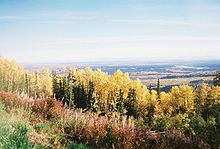Alaska Interior
Alaska Interior is the largest region of the US state Alaska , which includes a large part of the inland with the Wrangell Mountains and the Alaska range with the Denali . In the north it is bounded by the Brook chain . Low ranges of hills with poplar and birch forests run through the region.
In addition to Fairbanks , Alaska's second largest city, Tok , Talkeetna , Eagle , Glennallen , Delta Junction , Nenana , Healy and Cantwell are in the interior. The Trans-Alaska Pipeline traverses the region in a north-south direction. The Yukon flows from Canada coming through the Interior to the Bering Sea .
The interior is a zone of discontinuous permafrost soil with a tendency towards continuous permafrost near the Arctic Circle . Northern lights can be seen in the sky on clear winter nights .
climate
The Interior is the region with the greatest extreme weather conditions in Alaska. There is a continental climate without the balancing influence of an ocean, as is the case in the peripheral regions of Alaska. The average temperatures in Fairbanks are -24 ° C in winter and +17 ° C in summer. The lowest temperature in the Interior and also in Alaska was measured in 1971 at -62 ° C at Prospect Creek . The highest temperature in the Interior and also in Alaska was measured on June 27, 1915 at 38 ° C near Fort Yukon .
The interior is shielded from the humid air masses of the Pacific Ocean by the high barrier of the Alaska range . The average annual rainfall is 360 mm. Interior storms usually form in the Gulf of Alaska .
Web links
- National Park Service: Archeology of Interior Alaska ( January 20, 2012 memento in the Internet Archive )

